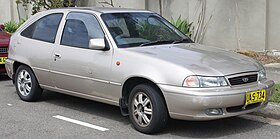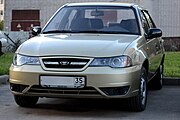Daewoo LeMans
Daewoo LeMans
From Wikipedia, the free encyclopedia
(Redirected from Daewoo Racer)
| Daewoo LeMans | |
|---|---|

Pontiac LeMans 5-door (New Zealand)
| |
| Overview | |
| Manufacturer | Daewoo |
| Production | 1986–1997 (South Korea) 1995–present (license-built models) |
| Body and chassis | |
| Class | Compact car |
| Body style | 3-door hatchback 4-door sedan 5-door hatchback |
| Layout | Transverse front-engine, front-wheel drive |
| Platform | GM T platform |
| Related | Opel Kadett E |
| Chronology | |
| Predecessor | Daewoo Maepsy Pontiac Acadian Pontiac T-1000 Pontiac Sunburst (Canada) |
| Successor | Daewoo Lanos Daewoo Nubira |
The Daewoo LeMans is a compact car, first manufactured by Daewoo in South Korea between 1986 and 1994, and between 1994 and 1997 as Daewoo Cielo—a car mechanically identical to the LeMans, differentiated only by its modified styling cues. Like all Daewoos preceding it, the LeMans took its underpinnings from a European Opel design. In the case of the LeMans, the GM T platform-based Opel Kadett E was the donor vehicle, essentially just badge engineered into the form of the LeMans, and later as the Cielo after a second more thorough facelift.
In markets outside of South Korea, the original version of the car bore the Asüna GT, Asüna SE, Daewoo 1.5i, Daewoo Fantasy, Daewoo Pointer, Daewoo Racer, Passport Optima and Pontiac LeMans names. The "LeMans" nameplate was not used at all for the facelifted model. Five-door hatchback models exported to Europe were badged Daewoo Nexia with the Daewoo Racer name used seemingly at random on various bodystyles. The Daewoo Heaven name has also been used.
The Cielo was subsequently replaced by the subcompact Daewoo Lanos and the compact Nubira in 1997, except in some Central Asian markets for which production of the four-door continues in Uzbekistan.
Daewoo LeMans (1986–1994)[edit]
| Daewoo LeMans | |
|---|---|

1988 Pontiac LeMans sedan (United States)
| |
| Overview | |
| Also called | Asüna GT (Canada, 1991–1993 hatchback) Asüna SE (Canada, 1991–1993 sedan) Daewoo 1.5i (Australia, 1994–1995) Daewoo Fantasy (Thailand) Daewoo Racer Daewoo Pointer Passport Optima (Canada, 1988–1991) Pontiac LeMans |
| Production | 1986–1994 |
| Body and chassis | |
| Platform | GM T platform |
| Powertrain | |
| Engine | |
| Transmission | 4/5-speed manual 3-speed automatic |
| Dimensions | |
| Wheelbase | 2,520 mm (99.2 in) |
| Width | 1,662 mm (65.4 in) |
| Height | 1,393 mm (54.8 in) |
| Chronology | |
| Predecessor | Daewoo Maepsy-Na |
| Successor | Daewoo Cielo |
The original series Daewoo LeMans was available as a three-door hatchback and a four-door sedan when introduced in July 1986.[1] Sales of the LeMans in North America began in 1988, where it was sold as the Pontiac LeMans. The LeMans was one of the first aerodynamically designed cars to be sold in South Korea, and the first to feature a digital dashboard.[1]
For the 1989 model year in the US, more models were released: the new lineup included a sportier Pontiac LeMans GSE, positioned similarly to the Opel Kadett GSi, equipped with a 96 hp (72 kW) 2.0-litre four-cylinder engine. The GSE was available in a monochromatic paint scheme in red, white or silver with 14 inch alloy wheels, fog lights and a rear spoiler. The GSE also received the Recaro-style seats of the Kadett. A Pontiac LeMans SE sedan with upgraded equipment from the base and LE models also had the 96 hp (72 kW) 2.0-litre four-cylinder engine, also used in the Pontiac Sunbird. In North America, poor quality tarnished sales and the Pontiac LeMans and Asüna SE/GT were discontinued after 1993 with no replacement. Later that year, the Asüna brand was discontinued altogether.
The five-door hatchback body style was known as the Daewoo LeMans Penta5 in South Korea, while the three-door was called Daewoo Racer and only the sedan was called LeMans. Korean market cars received a 1.5-litre engine (with 89 PS or 65 kW) as there was a severe tax penalty for cars with larger engines.[1] In October 1991 the LeMans received a facelift, with a reworked front and superficially changed taillights. This version was called the Asüna SE/GT in the Canadian market, where it replaced the Passport Optima. When South Korean production of the original LeMans finally came to an end in February 1997, over 1 million had been built.[1]
This car was sold in Australia as the "Daewoo 1.5i", with both hatchback and sedan bodywork. It was sold in New Zealand as the Pontiac LeMans from 1989, becoming the first Pontiac badged car to be sold on the NZ market since the Canadian sourced Pontiac Laurentian of the 1960s.
Gallery[edit]
|
Daewoo Cielo (1994–1997)[edit]
| Daewoo Cielo | |
|---|---|

1995-1997 Daewoo Cielo GLX 3-door
| |
| Overview | |
| Also called | Daewoo Cielo Daewoo Heaven Daewoo Nexia Daewoo Racer Daewoo Super Racer Chevrolet Nexia |
| Production | 1994–1997 (South Korea) 1995–2002 (Vietnam) 1996–2008 (Egypt) 1996–2007 (Romania) 1996–2016 (Uzbekistan) |
| Assembly | Bupyeong, South Korea Cairo, Egypt (Daewoo Motors Egypt) Asaka, Uzbekistan (UzDaewoo)[2] Craiova, Romania (Rodae)[3] Lublin, Poland (DMP)[4] Hanoi, Vietnam (VIDAMCO)[5] Kerman, Iran {{(Kerman Motor)|date=March 2012}} |
| Powertrain | |
| Engine | |
| Transmission | |
| Dimensions | |
| Wheelbase | 2,520 mm (99 in) |
| Length | 4,482 mm (176 in) (sedan) 4,256 mm (168 in) (hatchback) |
| Width | 1,662 mm (65 in) |
| Height | 1,393 mm (55 in) |
| Chronology | |
| Successor | Daewoo Lanos |
The second generation LeMans launched in 1994, available as a three- and five-door hatchback and four-door sedan with a 1.5-litre eight-valve or a 1.5-litre 16-valve engine. These new models were still based on the Opel Kadett E, underpinned by the "T-car" platform. There were various trim levels available; in the United Kingdom, where the car sold as the Daewoo Nexia, these were GLi (8-valve) and GLXi (16-valve) for the general public, with a "base" model available for large contracts. Unlike the Kadett, there was never a station wagon version available. Some European markets got the "Lifestyle" trim level; Spain and Portugal badged their GLi/GLXi equivalents "Chess"; the Benelux countries kept the GLi/GLXi trim levels and some markets added ETi and STi specifications.[6] The GLi has an average performance with a 0–100 km/h time of 12.5 seconds and 80 PS (59 kW) at 5,400 rpm. There was also a version with single-point fuel injection and 70 PS (51 kW) for lower-spec versions.[6] The more luxurious GLXi received a sixteen-valve engine which upped the power to 90 PS (66 kW) at an unusually low 4,800 rpm, and the 0–100 km/h time was reduced to 12.2 seconds.[7]
The Cielo was made in India by DCM Daewoo Motors until the Korean Daewoo company went bankrupt. GM did not take over the Indian plant in Surajpur near Delhi and it was liquidated. Production in South Korea came to an end shortly after the 1996 introduction of the Daewoo Lanos, an original design.
Daewoo first exported cars to Europe in the mid 1990s, with the Nexia and Espero forming the two-model line-up in Britain from January 1995. Daewoo was the first manufacturer to sell cars on the British market directly to customers rather than setting up a conventional dealer network, and the appeal of its cars was further enhanced by a low and fixed asking price as well as a comprehensive warranty and free servicing for three years after the car's sale. Despite making use of a design which was by then more than a decade old, the Nexia was one of the most popular budget family cars in Britain and helped Daewoo gain a 1% share of the new car market in 1996. It was replaced there by the Lanos in the autumn of 1997, by which time some 40,000 examples had been sold.
Marketing and production[edit]
Romania[edit]
In Romania, manufacturing began in 1996, at the newly acquired Daewoo Automobile Romania factory in Craiova, being the first Daewoo model produced at the plant.[8] It was offered only with the sedan body style,[9]and was exported to most countries in Central and Eastern Europe.[10] The GLE version, which was the full option model, included air conditioning, power steering, front and rear electric windows, fog lamps, central locking, tachometer and a cassette player stereo system. Unlike models intended for Central and Western Europe, the cars sold in Romania (either imported or produced here) were never equipped with ABS or airbags.
In 2000, the model range was extended with the new Executive level, which featured a distinctive chromed grille and borrowed elements from the GLX, such as 14-inch wheels, bigger 256 mm ventilated disk brakes and the double overhead camshaft engine with 16 valves, that offered an increased power output.[11] The Executive also received an electronic ignition distributor from the Lanos. Another addition to the 2000 model was the catalytic converter respecting Euro 2 emission standards. In 2004, because of harsher emission regulations, the factory installed the Lanos 1.5 SOHC engine, which meant a decrease in horsepower, but made the car Euro 3 compliant. During the last 2 years of production, in an effort to update the optional equipment available for the car, the Executive received a CD player instead of the obsolete cassette player. It remained in production until 2007, being marketed along with its successor, the Daewoo Nubira.[12]
| Model | Engine Code | Years | Displacement | Weight (kg) | Power | Torque | 0–100 km/h | Emissions |
|---|---|---|---|---|---|---|---|---|
| 1.5 L 8V | G15MF | 1996-2000 | 1498 cc | 1025 | 75 hp at 5400 rpm | 127 N·m at 3200 rpm | 12,5 s | Non-Euro |
| 1.5 L 16V | A15MF | 2000-2004 | 1498 cc | 1088 | 84 hp at 4800 rpm | 136 N·m at 3400-4600 rpm | 12,2 s | Euro 2 |
| 1.5 L 8V | A15SMS | 2004-2007 | 1498 cc | 1078 | 80 hp at 5600 rpm | 123 N·m at 3200 rpm | 12,8 s | Euro 3 |
Uzbekistan[edit]
In Uzbekistan, UzDaewooAuto continues to manufacture the four-door sedan version of the Nexia, of which production began in June 1996.[13] It is produced alongside other Daewoo and Chevrolet models, and is exported in other countries such as Kazakhstan, Russia, Moldova, Azerbaijan and Ukraine.
It is available with three engines: a 1.5-litre SOHC (56 kW or 75 hp), 1.5-litre DOHC (62 kW or 83 hp) and 1.6-litre DOHC (81 kW or 109 hp). The 1.6 version has more powerful brakes and transmission with an additional long main gear.
A facelifted version of the car, known as the Nexia II, was presented in Tashkent, Uzbekistan, in 2008.[14] It was designed in the UK by Concept Group International LTD with cooperation of GM-Uzbekistan. In Uzbekistan, it is currently marketed under the Chevrolet brand, while some export markets (in the CIS area) continue to receive the car as the Daewoo Nexia.
Gallery[edit]
|










0 Comments:
Post a Comment
Subscribe to Post Comments [Atom]
<< Home